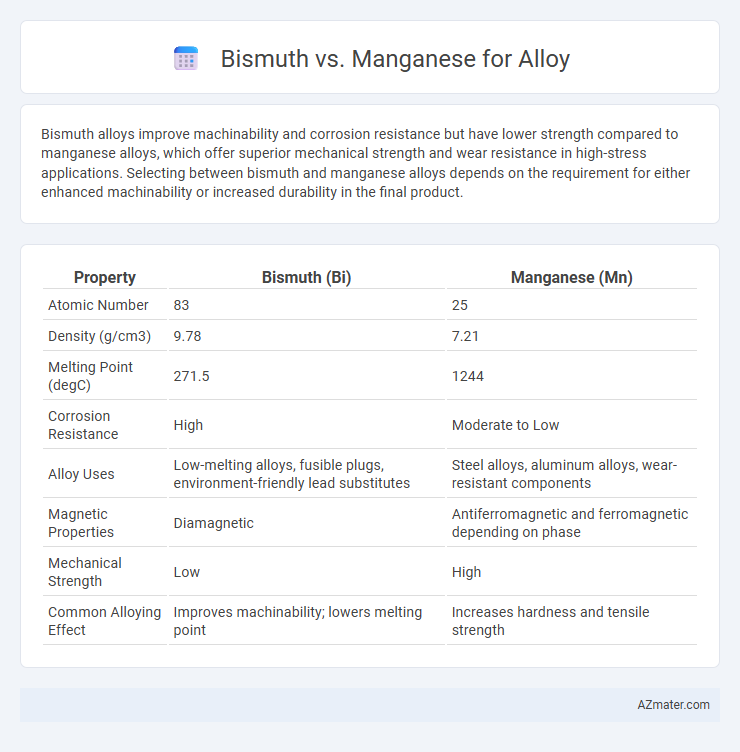Bismuth alloys improve machinability and corrosion resistance but have lower strength compared to manganese alloys, which offer superior mechanical strength and wear resistance in high-stress applications. Selecting between bismuth and manganese alloys depends on the requirement for either enhanced machinability or increased durability in the final product.
Table of Comparison
| Property | Bismuth (Bi) | Manganese (Mn) |
|---|---|---|
| Atomic Number | 83 | 25 |
| Density (g/cm3) | 9.78 | 7.21 |
| Melting Point (degC) | 271.5 | 1244 |
| Corrosion Resistance | High | Moderate to Low |
| Alloy Uses | Low-melting alloys, fusible plugs, environment-friendly lead substitutes | Steel alloys, aluminum alloys, wear-resistant components |
| Magnetic Properties | Diamagnetic | Antiferromagnetic and ferromagnetic depending on phase |
| Mechanical Strength | Low | High |
| Common Alloying Effect | Improves machinability; lowers melting point | Increases hardness and tensile strength |
Introduction to Bismuth and Manganese in Alloys
Bismuth and manganese play distinct roles in alloy compositions, with bismuth primarily used as a non-toxic replacement for lead to improve machinability and reduce environmental impact. Manganese is essential as an alloying element in steel production, enhancing strength, hardness, and wear resistance through its ability to stabilize austenite and improve deoxidation. The interplay between bismuth's low toxicity and manganese's mechanical fortification highlights their tailored applications in modern metallurgical processes.
Chemical and Physical Properties Compared
Bismuth exhibits a low melting point of 271degC and high density of 9.78 g/cm3, making it ideal for low-melting alloys and improving machinability by reducing brittleness. Manganese, with a higher melting point of 1244degC and lower density of 7.21 g/cm3, enhances alloy strength, corrosion resistance, and wear resistance due to its strong affinity for sulfur and oxygen. The chemical inertness of bismuth contrasts with manganese's active participation in oxidation-reduction reactions, influencing their applications in specialized alloy compositions.
Melting Points and Thermodynamic Behavior
Bismuth has a melting point of 271.5degC, significantly lower than manganese's melting point of 1246degC, making bismuth suitable for low-temperature alloys and fusible applications. Thermodynamically, bismuth exhibits low solubility and limited solid solubility in most metals, enhancing its use in creating brittle phases that improve machinability. Manganese, with a high melting point and strong affinity for oxygen, contributes to alloy strength and corrosion resistance through stable oxide formation and favorable thermodynamic stability in steel and aluminum alloys.
Alloying Characteristics and Compatibility
Bismuth in alloys improves machinability by creating brittle inclusions, making it ideal for free-cutting steels and lead-free replacements without compromising conductivity. Manganese enhances alloy strength, hardness, and wear resistance through solid solution strengthening and inclusion deoxidation, commonly used in steel and aluminum alloys. Compatibility-wise, bismuth offers better environmental benefits and works well in low-melting-point alloys, while manganese excels in high-strength, durable applications due to its strong interaction with iron matrices.
Impact on Mechanical Strength
Bismuth in alloys generally reduces mechanical strength due to its low melting point and tendency to create weak grain boundaries, resulting in decreased ductility and tensile strength. In contrast, manganese enhances mechanical strength by improving hardness, tensile strength, and resistance to wear through solid solution strengthening and grain refinement. Selecting between bismuth and manganese depends on the desired balance between machinability and mechanical performance in alloy applications.
Corrosion Resistance: Bismuth vs Manganese
Bismuth offers moderate corrosion resistance by forming a protective oxide layer, but it is generally softer and less durable in harsh environments compared to manganese. Manganese enhances alloys with superior corrosion resistance, especially in acidic and oxidative conditions, due to its ability to improve passivation and reduce pitting. Alloys with manganese are preferred in applications requiring long-term resistance to corrosion, whereas bismuth is often used for improving machinability rather than durability.
Toxicity and Environmental Considerations
Bismuth is favored over manganese in alloys due to its low toxicity and excellent environmental safety profile, making it suitable for applications requiring non-toxic materials. Manganese, while essential in steel manufacturing for strength and durability, poses higher health risks through inhalation of dust or fumes and can contribute to environmental pollution. Selecting bismuth reduces hazardous exposure and ecological impact, aligning with increasing regulatory standards for safer, more sustainable metal alloys.
Industrial Applications and Use Cases
Bismuth alloys are prized in industrial applications for their low toxicity, excellent machinability, and unique properties such as expansion upon solidification, making them ideal for precision casting, heat-sensitive fusible plugs, and environmentally friendly metal replacement. Manganese alloys enhance steel hardness, tensile strength, and wear resistance, proving essential in heavy machinery, automotive manufacturing, and construction industries. Both elements serve specific roles, with bismuth optimizing safety and environmental standards, while manganese focuses on mechanical performance and durability in alloy formulations.
Cost Efficiency and Availability
Bismuth offers moderate cost efficiency due to its lower toxicity and ease of machining, making it ideal for specialty alloys in automotive and electronic applications. Manganese is more abundant and significantly cheaper, providing excellent cost efficiency for large-scale steel alloys and enhancing hardness and wear resistance. Availability of manganese is high globally, supporting steady supply chains, while bismuth's limited sources can lead to higher prices and supply variability.
Conclusion: Choosing the Right Additive for Alloys
Bismuth enhances machinability and reduces toxicity in alloys, making it ideal for applications requiring improved environmental compliance and precision cutting. Manganese contributes significantly to strength, hardness, and wear resistance, best suited for structural alloys with demanding mechanical performance. Selecting between bismuth and manganese depends on balancing the need for machinability and environmental safety versus the need for increased durability and toughness in the final alloy.

Infographic: Bismuth vs Manganese for Alloy
 azmater.com
azmater.com